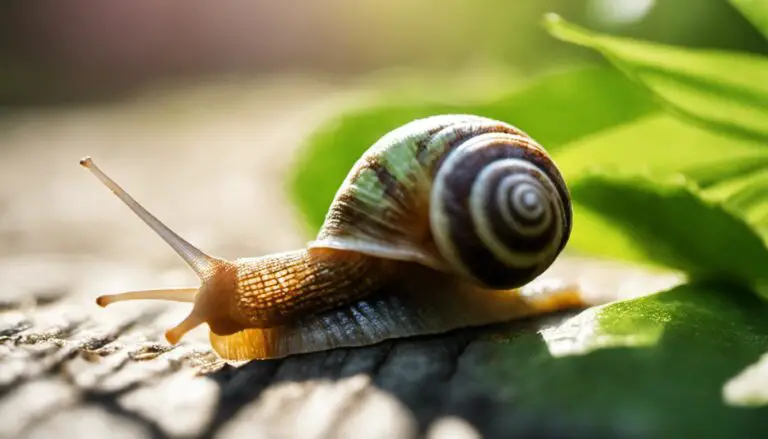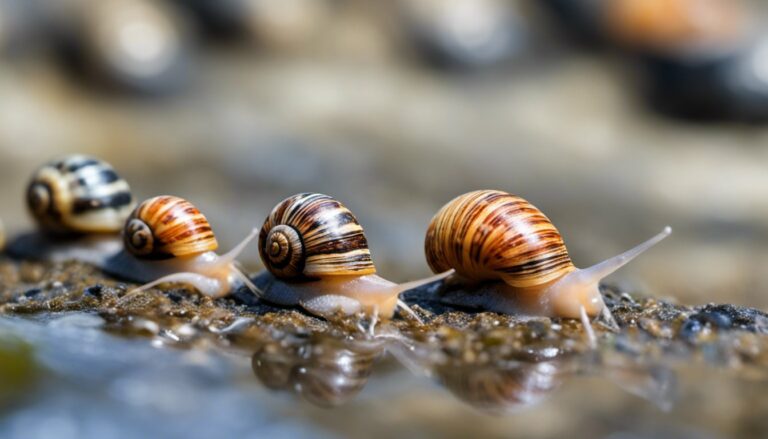How Do Snails Breathe? Land And Aquatic Snails

If you have ever thought about buying a snail as a pet, you’ve probably wondered, how do snails breathe? Many snails live on land, and you’ll find them crawling about in your garden. Do they breathe like mammals? Not exactly.

Still, other snails live in freshwater ponds and rivers, or the salty ocean. Do they breathe the same as the snails on land? How can pond snails go from spending long amounts of time underwater to crawling on the plants at the edge of the water?
How snails breathe differs depending on the type of snail, but each process is quite fascinating, so read on to learn more.
Contents
Table of Contents
What Is A Snail?
Snails are invertebrates. More specifically, they are mollusks, meaning that their bodies don’t contain any kind of skeleton or bones. How do they protect themselves? They carry around a hard shell on their back that guards them against harm. Although these soft-bodied animals are similar to slugs, they are set apart by the protective home they carry on their backs.
Snails are one of the oldest species still alive today, with their ancestors dating back 500 million years. There are thousands of different snails living on both land and in water. You can find them everywhere from your front yard, to frigid mountains, to steaming hydrothermal vents.
Different kinds of snails have plenty of similarities and differences, but the thing that truly sets each species apart is how they breathe. Not all snails breathe the same way, and their respiratory systems are quite complex.
Some snails have lungs where they only breathe air, and others have only gills that allow them to breathe water, deriving oxygen from the water. Still, there are some snail species that have both gills and lungs so that they can breathe both air and water.
Do Snails Breathe Air?
The simplest question to answer is: do snails breathe oxygen? All snails breathe air, one way or another. Most snails are only equipped with a lung so they are required to breathe dry air to survive. Regardless, even snails that only have a gill or gills breathe air, they just do so differently. We’ll go into further detail about this later.
How Do Snails Breathe?
The way snails breathe varies between types of snails. They all breathe air, but the way the go about taking in air is different.
As stated above, most snails have a lung to breathe air, but others have gills. Some snails have a lung and gills, giving them more adaptability. There are even aquatic snails that don’t have gills and have to surface to breathe air.
You may be thinking that this sounds confusing. So, how does a snail breathe? To dive deeper into how each of these processes work, keep reading below.
How Do Land Snails Breathe?
All terrestrial snails live by breathing air. While some can also breathe water, this is not as common, and most land snails have only one lung. Snails that breathe by only using a lung are called pulmonate snails.
Breathing With a Lung
Snails have a body part called a “mantle” that covers their internal organs as protection. The mantle is similar to skin, but is muscular and it lines the inside of the snail’s shell.
Snails use this mantle to expand and compress the muscles of their lung allowing them to breathe.
The Pneumostome
There is an opening on the right side of the snail’s mantle called the “pneumostome” that can be opened and closed when the snail chooses. While they draw air into their lungs, they can also expel carbon dioxide at will.
The pneumostome is the opening where snails take in oxygen and rid themselves of carbon dioxide. They do not continually keep the pneumostome open, but strive to keep it closed when they are not actively breathing because it helps their body retain moisture.
Another interesting thing about the pneumostome is that it is also the opening in which snails expel food waste.
Breathing With Gills
There are some snails, the Prosobranchia snails, that can breathe with gills as well as lungs. These snails have comb gills that allow the snail to gather oxygen from the water around them.
This is an inadequate way of receiving air, so although these snails can survive underwater for a time, they cannot stay there forever.
Ancient Breathing
In the past, there were snails that would breathe dry air through their pallial cavity wall, otherwise known as their mantle. There was a system of blood vessels within their mantle that acquired oxygen through the skin when the snail was submerged in water.
Because breathing through the mantle itself leaves snails at risk of losing vital water in their body through evaporation, this method has been mostly reduced or eliminated.
Today, land snails gather air through the pneumostome which prevents their body from losing water.

How Do Snails Breathe Underwater?
Can snails breathe underwater? Is it even possible? If you’ve ever seen a snail in an aquarium or in the ocean, then you know the answer is yes.
Gills
Aquatic snails have ctenidium, or comb gills, found on their pallial cavity that allows them to breathe the surrounding water. Feather-like protrusions from the gills allow the snail to absorb oxygen from the water and diffuse carbon dioxide.
Older species of these snails still have two comb gills on their bodies, but most snails today only have one.
Some aquatic snails do not have full gills, but instead have reduced gills that require the wall of the mantle cavity to get oxygen from the surrounding water. While these snails do still have reduced gills, they rely largely on their lung to survive.
Lungs
These snails are pulmonate snails, the same as the land snails above. Because they rely on dry air to survive, they need to regularly surface to breathe air.
Some of these snails utilize water tension to crawl across the underside of the surface of the water. This allows them to eat algae while breathing air outside of the water.
How Do Mystery Snails Breathe?
Mystery snails are a type of snail that has both gills and a lung. While they primarily live and breathe in water, they are able to explore on land for a time. They have an organ called a siphon that they stick above the surface of the water to breathe air while they are submerged.
Ultimately, they cannot survive on land for long and will dry up in a few hours.
Watch this video: How Do Snails Breathe? Land And Aquatic Snails
How Do Pond Snails Breathe?
Unlike what you’d think, pond snails, or Lymnaea, breathe air but live in water. They fill their pallial cavity with water to derive oxygen from it. They can do this even though they are lunged snails and do not have gills.
Being able to acquire oxygen this way is especially important when the surface of the pond is frozen and they are unable to surface for air.
Some pond snails can live underwater full time because of the oxygen their body pulls from the water. Others need to surface periodically to breathe dry air.
How Do Sea Snails Breathe?
Most sea snails breathe strictly with one or two gills, but there are a few species that live in the ocean that breathe air with a lung.
These snails live in the intertidal regions of the ocean, so they only breathe when the tide is low and they are safe to come out of their shells. When the tide is high and they’re submerged, they hide inside their shells.
Conclusion
How snails breathe is complex and differs between types of snails. The way they breathe has changed throughout the years so that they are equipped with what best helps them now.
Most snails have a lung to breathe air, even some snails that live the majority of their lives underwater. Still, many snails have gills, like the ones living in the ocean. There are even snails that have both a gill and lung, allowing them to easily go between land and water.
Between their adaptable breathing techniques and their hard, protective shell home, snails have certainly learned how to survive.
Click here to learn what snails need to survive, here for whether they need water and here for whether they change shells. You can also find all our snail guides here.


![Do Snails Change Shells? [Full Guide]](https://allourcreatures.com/wp-content/uploads/2021/11/snails-and-shell-768x511.jpg)
![Do Snails Need Water? [Complete Guide]](https://allourcreatures.com/wp-content/uploads/2021/11/do-snails-need-water-768x513.jpg)
![What Do Apple Snails Eat? [Full Guide]](https://allourcreatures.com/wp-content/uploads/2021/10/what-do-apple-snails-eat-768x512.jpg)

![Do Snail Shells Grow? [Full Guide]](https://allourcreatures.com/wp-content/uploads/2021/11/growing-snail-shells-768x501.jpg)
